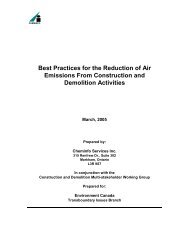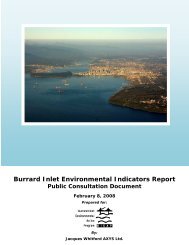Dredge Management Guidelines - the BIEAP and FREMP Website
Dredge Management Guidelines - the BIEAP and FREMP Website
Dredge Management Guidelines - the BIEAP and FREMP Website
Create successful ePaper yourself
Turn your PDF publications into a flip-book with our unique Google optimized e-Paper software.
Guiding Principles for Dredging Task Group<br />
In scoping <strong>the</strong> issues associated with developing <strong>the</strong> budget <strong>and</strong> reviewing existing guidelines, <strong>the</strong><br />
Task Group used <strong>the</strong> following principles to guide <strong>the</strong>ir deliberations.<br />
Dredging must be managed to ensure that:<br />
· habitat values <strong>and</strong> fishery resources are preserved. This will involve continued habitat protection<br />
<strong>and</strong> enhancement throughout <strong>the</strong> estuary.<br />
· navigation channels are maintained in such a way that reliable channel depths are available on a<br />
consistent basis to serve <strong>the</strong> evolving coastal <strong>and</strong> deep sea shipping markets. This will require a<br />
managed dredging program.<br />
· industry’s dem<strong>and</strong> for s<strong>and</strong> is met on an environmentally sustainable basis. This will require monitoring<br />
sediment inflow <strong>and</strong> controlling s<strong>and</strong> withdrawals on an annual basis in order to evaluate <strong>the</strong><br />
effects of dredging <strong>and</strong> o<strong>the</strong>r development activities.<br />
· disposal of contaminated dredge material is properly managed <strong>and</strong> appropriate upl<strong>and</strong> <strong>and</strong> offshore<br />
disposal sites are used. Testing of dredge material for contaminants using defined testing<br />
procedures <strong>and</strong> st<strong>and</strong>ards will be needed to assess <strong>the</strong> impacts <strong>and</strong> fate of contaminants that may<br />
be found.<br />
· public health <strong>and</strong> safety needs are met. This will require that all efforts are taken to maintain <strong>the</strong><br />
structural integrity of utility crossings <strong>and</strong> river dykes.<br />
Task Group Conclusions<br />
In order to better assess <strong>and</strong> manage dredging projects in <strong>the</strong> <strong>FREMP</strong> Area of Interest, <strong>the</strong> Task Group<br />
recommended that:<br />
· annual sediment budgets be established to guide dredging activities;<br />
· annual reports be produced describing <strong>the</strong> previous year’s dredging activity. This requires <strong>the</strong> ability<br />
to track removals through a S<strong>and</strong> “registry”.<br />
· that a technical group be made available to advise <strong>FREMP</strong>’s ERC on <strong>the</strong> technical merits of any proposal,<br />
as needed.<br />
The <strong>Dredge</strong> <strong>Management</strong> Advisory Committee is now responsible for <strong>the</strong>se tasks. Their Terms of<br />
Reference are included in <strong>the</strong> appendices to this document.<br />
10 Part 1: Introduction
















